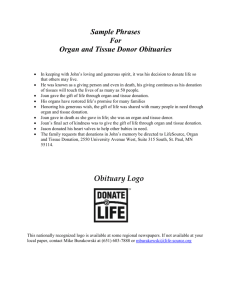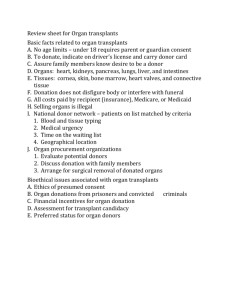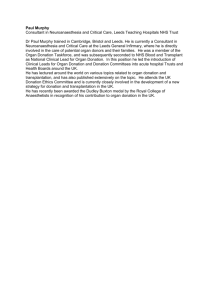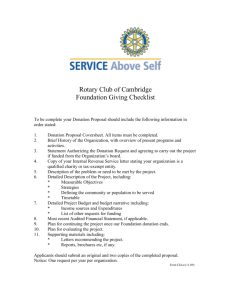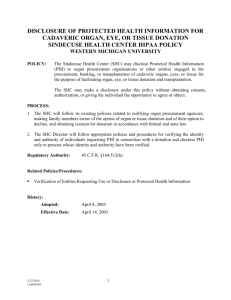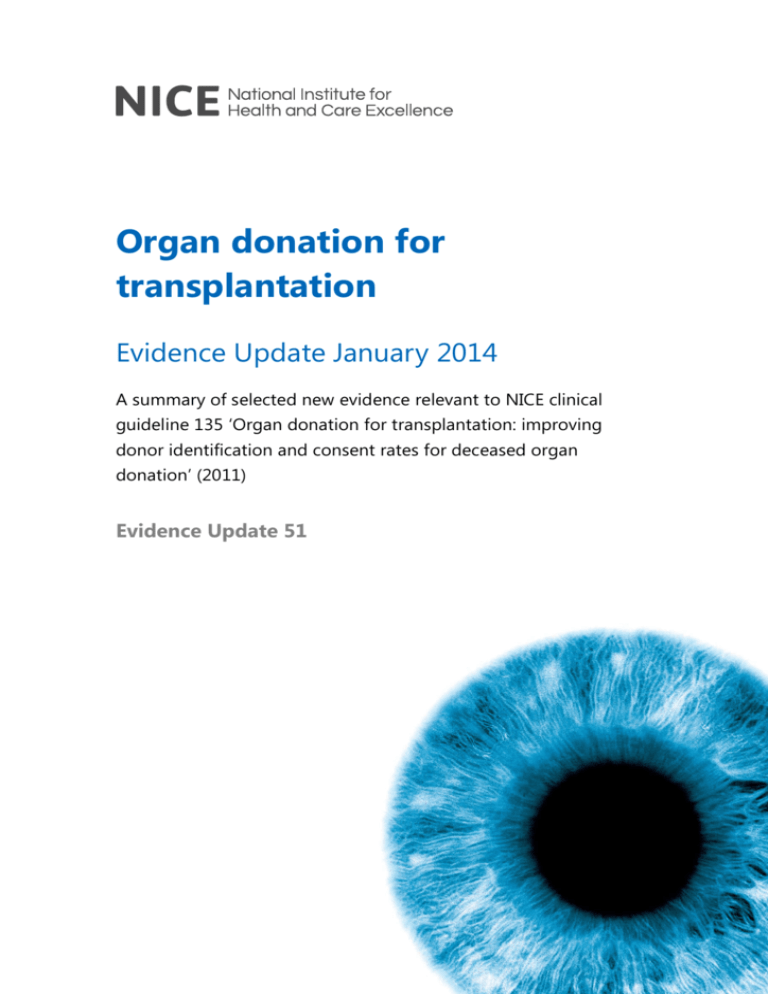
Organ donation for
transplantation
Evidence Update January 2014
A summary of selected new evidence relevant to NICE clinical
guideline 135 ‘Organ donation for transplantation: improving
donor identification and consent rates for deceased organ
donation’ (2011)
Evidence Update 51
Evidence Updates provide a summary of selected new evidence published since the literature
search was last conducted for the accredited guidance they relate to. They reduce the need
for individuals, managers and commissioners to search for new evidence. Evidence Updates
highlight key points from the new evidence and provide a commentary describing its strengths
and weaknesses. They also indicate whether the new evidence may have a potential impact
on current guidance. For contextual information, this Evidence Update should be read in
conjunction with ‘Organ donation for transplantation: improving donor identification and
consent rates for deceased organ donation’ (NICE clinical guideline 135).
Evidence Updates do not replace current accredited guidance and do not provide
formal practice recommendations.
NICE Evidence Services are a suite of services that provide online access to high quality,
authoritative evidence and best practice.
National Institute for Health and Care Excellence
Level 1A
City Tower
Piccadilly Plaza
Manchester M1 4BT
www.nice.org.uk
© National Institute for Health and Care Excellence, 2014. All rights reserved. This material
may be freely reproduced for educational and not-for-profit purposes. No reproduction by or
for commercial organisations, or for commercial purposes, is allowed without the express
written permission of NICE.
Evidence Update 51 – Organ donation for transplantation (January 2014)
2
Contents
Introduction ........................................................................................................................... 4
Key points ............................................................................................................................. 5
1
2
Commentary on new evidence ....................................................................................... 6
1.1
Identifying patients who are potential donors .......................................................... 6
1.2
Patients who have capacity .................................................................................... 9
1.3
Assessing best interests......................................................................................... 9
1.4
Seeking consent to organ donation ...................................................................... 11
1.5
Approach to those close to the patient .................................................................. 11
1.6
Discussions in all cases ....................................................................................... 11
1.7
Organisation of the identification, referral and consent processes ......................... 16
New evidence uncertainties ......................................................................................... 18
Appendix A: Methodology .................................................................................................... 19
Appendix B: The Evidence Update Advisory Group and Evidence Update project team ....... 22
Evidence Update 51 – Organ donation for transplantation (January 2014)
3
Introduction
This Evidence Update identifies new evidence that is relevant to, and may have a potential
impact on, the following reference guidance:
1
Organ donation for transplantation. NICE clinical guideline 135 (2011)
A search was conducted for new evidence from 1 June 2010 to 14 August 2013. A total of
1722 pieces of evidence were initially identified. Following removal of duplicates and a series
of automated and manual sifts, 11 items were selected for the Evidence Update (see
Appendix A for details of the evidence search and selection process). An Evidence Update
Advisory Group, comprising topic experts, reviewed the prioritised evidence and provided a
commentary.
Although the process of updating NICE guidance is distinct from the process of an Evidence
Update, the relevant NICE guidance development centres have been made aware of the new
evidence, which will be considered when guidance is reviewed.
NICE Pathways
•
Organ donation for transplantation. NICE Pathway
Feedback
If you have any comments you would like to make on this Evidence Update, please email
contactus@evidence.nhs.uk
1
NICE-accredited guidance is denoted by the Accreditation Mark
Evidence Update 51 – Organ donation for transplantation (January 2014)
4
Key points
The following table summarises what the Evidence Update Advisory Group (EUAG) decided
were the key points for this Evidence Update. It also indicates the EUAG’s opinion on whether
the new evidence may have a potential impact on the current guidance listed in the
introduction. For further details of the evidence behind these key points, please see the full
commentaries.
The section headings used in the table below are taken from the guidance.
Evidence Updates do not replace current accredited guidance and do not provide
formal practice recommendations.
Potential impact
on guidance
Key point
Identifying patients who are potential donors
• Assessment tools, particularly the Full Outline of
UnResponsiveness (FOUR) score, may be of some use in
identifying patients likely to become eligible for donation after
brainstem death (DBD).
• Uncontrolled donation after circulatory death (DCD) in the
emergency department and the techniques necessary for organ
preservation appear to be acceptable to patients and relatives.
• Neonatal DCD might provide a means of increasing the pool of
potential organ donors.
Assessing best interests
• Personal religious and cultural beliefs, family relationships,
knowledge of the organ donation process and attitudes towards
the healthcare system can affect people’s views on DBD and
DCD.
Discussions in all cases
• The consent discussion should be timed sensitively, and those
close to the patient should receive understandable information on
organ donation to support their decision.
• Age, ethnicity, culture and religion of patients and those close to
them, may influence the likelihood of consent.
• The effect on consent to organ donation of offering relatives the
opportunity to be present during determination of neurological
death in a family member is unclear.
• Providing those close to the patient with support during consent, in
particular providing information on neurological death and the
consent process and time to consider the information, can improve
the likelihood of consent.
Organisation of the identification, referral and consent processes
• Education of healthcare professionals and the general public on
organ donation procedures could positively influence attitudes
towards donation and consent rates.
Evidence Update 51 – Organ donation for transplantation (January 2014)
Yes
No
5
1
Commentary on new evidence
These commentaries analyse the key references identified specifically for the Evidence
Update. The commentaries focus on the ‘key references’ (those identified through the search
process and prioritised by the EUAG for inclusion in the Evidence Update), which are
identified in bold text. Section headings are taken from the guidance.
1.1
Identifying patients who are potential donors
NICE clinical guideline 135 (NICE CG135) recommends that all patients who are potentially
suitable organ donors should be identified as early as possible, through a systematic
approach. While recognising that clinical situations vary, identification should be based on
either of the following criteria:
•
defined clinical trigger factors in patients who have had a catastrophic brain injury,
namely:
− the absence of one or more cranial nerve reflexes and
− a Glasgow Coma Scale (GCS) score of 4 or less that is not explained by sedation
unless there is a clear reason why the above clinical triggers are not met (for example
because of sedation) and/or a decision has been made to perform brainstem death tests,
whichever is the earlier
•
the intention to withdraw life-sustaining treatment in patients with a life-threatening or lifelimiting condition which will, or is expected to, result in circulatory death.
Identifying potential DBD donors using clinical triggers
A retrospective study by de Groot et al. (2011) tested 3 tools for identifying patients who may
imminently become brainstem dead and who would, therefore, have been potential heartbeating organ donors (also known as donation after brainstem death [DBD] donors). A total of
564 patients diagnosed with subarachnoid haemorrhage, traumatic brain injury or
intracerebral haemorrhage were identified over a 3 year period at a single intensive care unit
(ICU) in the Netherlands. Data on patient demographics, brain activity (GCS and last known
brainstem reflexes), clinical outcome and whether or not organs were procured were
extracted from medical records. The 3 tools used to identify patients with imminent brain or
neurological death (and therefore identify potential donors) were:
•
•
•
Full Outline of UnResponsiveness (FOUR) score:
Imminent brainstem death=FOUR score of E 0 M 0 B 0 R 0 : eyelids remaining closed with
pain; no response to pain or generalised myoclonus status; absent pupillary, corneal and
cough reflex; and absence of spontaneous ventilation or apnoea.
GCS:
Imminent brainstem death=GCS score of 3 (no eye opening to pain, no verbal response
and no motor response to pain) and absence of at least 3 out of 6 brainstem reflexes.
Organ Procurement Transplantation Network (OPTN) definition:
Imminent neurological death defined as ‘a patient … with severe neurological injury and
requiring ventilator support, who upon clinical evaluation … has an absence of at least
3 brainstem reflexes’.
Evidence Update 51 – Organ donation for transplantation (January 2014)
6
Of the 179 patients in the cohort who died, 36 (20%) became organ donors (23 DBD donors
and 13 donation after circulatory death [DCD] donors). For each of the tools, the number of
potential DBD donors identified and the number of those who went on to become actual DBD
donors were:
•
•
•
FOUR score: 63 potential donors, 23 actual donors (37% donor conversion rate).
GCS: 85 potential donors, 23 actual donors (27% donor conversion rate).
OPTN definition: 88 potential donors, 23 actual donors (26% donor conversion rate).
The 3 tools did not identify 7 potential DBD donors, and most of the patients identified as
potential donors did not go on to fulfil official neurological death criteria.
Limitations of the evidence included that:
•
•
•
•
•
The study reported prediction of actual donation rather than progression to brainstem
death. Some patients whose relatives did not consent to organ donation before testing for
brainstem death may have progressed to brainstem death and thus been potential
donors.
The study was conducted at a single centre.
The study was retrospective and observational, so some potential donors may have been
missed.
GCS and absence of brainstem reflexes were recorded at different stages of treatment
across patients.
The FOUR score is not in common use in England and Wales.
Limited evidence suggests that assessment tools, particularly the FOUR score, may be of
some use in identifying patients likely to become eligible for DBD. These findings add to the
body of evidence supporting the clinical trigger factors to identify potentially suitable donors
among patients with catastrophic brain injury outlined in NICE CG135. A more specific trigger
may increase clinician uptake and use. Although indicating potential future refinements to
triggers, limitations of the evidence mean that these data are currently unlikely to have an
impact on guidance. Prospective studies are needed to determine whether these tools
improve identification and referral rates.
Key reference
de Groot YJ, Wijdicks EF, van der Jagt M et al. (2011) Donor conversion rates depend on the
assessment tools used in the evaluation of potential organ donors. Intensive Care Medicine 37: 665–70
Identifying potential DCD donors in the emergency department
NICE CG135 recommends identifying all patients who are potentially suitable donors as early
as possible, through a systematic approach. One of the criteria on which identification should
be based is ‘the intention to withdraw life-sustaining treatment in patients with a lifethreatening or life-limiting condition which will, or is expected to, result in circulatory death.’
The guideline makes no recommendations specific to ‘uncontrolled DCD’ after death in the
emergency department – for example, after a cardiac arrest where organ donation has not
been planned for – although evidence focusing on emergency departments was considered
during development of the recommendations.
A cross-sectional survey by Bruce et al. (2013) sought people’s opinions on uncontrolled
DCD. Patients and relatives aged over 15 years attending the emergency department of a
large teaching hospital in Scotland over a 3-day period were asked to complete a 17-item
questionnaire. The questions covered whether respondents would in theory be willing to
discuss and consent to organ donation soon after the circulatory death of a relative in the
emergency department. Respondents were also asked their thoughts on the acceptability of
3 organ preservation procedures: insertion of a small tube into the groin to deliver cold fluid,
continuation of mechanical chest compressions, and continuation of mechanical ventilation.
Evidence Update 51 – Organ donation for transplantation (January 2014)
7
During the study period, 200 questionnaires were completed (88% of respondents were white
British, mean age=40.4 years).
Willingness of people to discuss organ donation after confirmation of circulatory death in the
emergency department (72%) was no different than after confirmation of brainstem death in
an ICU (72%). Just over half (56%) of respondents said they would be willing to discuss organ
donation soon after the cardiac arrest of a relative in the emergency department (with 21%
not willing to discuss organ donation at this point, and 23% having no strong views). A similar
proportion (59%) would consider donating their relative’s tissues (such as corneas and heart
valves) in this situation, whereas 16% would not consider donation and 25% were undecided.
People were mostly happy for the 3 organ preservation procedures to be used after
circulatory death of a relative (48–69% thought the procedures were acceptable compared
with 9–28% who thought they were not). Respondents were significantly more likely to accept
the use of the 3 procedures after they had discussed organ donation than before the
discussion (p<0.001 for each of the 3 procedures), but only around one-fifth (21–28%) stated
that they thought use of such procedures before discussion was ‘not acceptable’.
Limitations of the evidence included that:
•
•
•
The study used a convenience sample.
Participants were asked about a theoretical scenario.
Response rate was not recorded, which precluded any comparison of the characteristics
of responders with non-responders.
Limited evidence suggests that uncontrolled DCD in the emergency department and the
techniques necessary for organ preservation appear to be acceptable to patients and
relatives. Uncontrolled DCD could act as a new source of potential donors in the UK in the
future. This evidence is consistent with the recommendation in NICE CG135 that patients who
will, or are expected to, reach circulatory death should be considered as potential organ
donors. Further research, along with continuing observation of the limited numbers of centres
performing this technique in the UK, is needed.
Key reference
Bruce CM, Reed MJ, MacDougall M (2013) Are the public ready for organ donation after out of hospital
cardiac arrest? Emergency Medicine Journal 30: 226–31
Identifying potential DCD donors in neonatal ICUs
Although NICE CG135 discusses arrangements for organ donation in paediatric ICUs,
neonatal ICUs are not specifically referred to. However, the recommendations in NICE
CG135 apply to any critical care setting. Two studies recently assessed the potential for
organ donation following circulatory death in neonates.
A retrospective study in the USA by Labrecque et al. (2011) examined the proportion of
deaths in neonatal ICUs that would theoretically have been eligible for DCD. Medical records
over a 3-year period at 3 level III neonatal ICUs were reviewed to identify infants born at
23 weeks’ gestation or later who subsequently died. Exclusion criteria were: postmenstrual
age less than 37 weeks and weight less than 3 kg at death; lack of mechanical ventilation at
time of withdrawal of life support; active infection (including HIV) or sepsis; active malignancy;
encephalopathy of unknown aetiology; and neurological death.
During the study period, the 3 neonatal ICUs admitted 7955 infants, with 192 deaths among
those born at a gestational age of 23 weeks or more. After exclusions, 16 (8%) infants had a
warm ischaemic time (defined as the interval from withdrawal of life support to circulatory
death) of less than 1 hour and were therefore potential liver and kidney DCD candidates. After
exclusions because of organ failure, the 16 infants would have yielded 14 livers and
18 kidneys. Of these 16 infants, 12 infants had a warm ischaemic time less than 30 minutes
Evidence Update 51 – Organ donation for transplantation (January 2014)
8
and were therefore also suitable candidates for cardiac DCD. After exclusions for vasoactive
medications and major congenital heart disease, the 12 infants would have yielded 10 hearts.
A similar retrospective study in the USA by Mathur et al. (2011) estimated the proportion of
neonates who might be potential candidates for cardiac DCD. Medical records of all infants
discharged over a 5-year period from 1 neonatal ICU were screened to identify those who
weighed more than 2.5 kg at the time of death and who died after planned withdrawal of life
support. Exclusion criteria were active sepsis, HIV infection, significant cardiac dysfunction,
congenital heart disease, death after cardiopulmonary resuscitation or neurological death,
and a ‘do not resuscitate’ order in place.
Over the 5-year study period, 266 deaths were recorded in the neonatal ICU, of which
117 (44%) were infants weighing more than 2.5 kg. After exclusions, 16 infants would have
been potential candidates for DCD. Only 5 of these infants (2% of all deaths, 4% of deaths in
infants weighing more than 2.5 kg) had a warm ischaemic time of 30 minutes or less and
therefore would have been suitable for cardiac DCD.
Limitations common to both studies included that:
•
•
•
The analyses were retrospective.
A minimum weight criterion of 2.5–3 kg would result in small organs that may have a
limited recipient pool.
A number of ethical issues exist with respect to organ donation and transplantation in
infants, in particular with cardiac DCD.
In addition, Labrecque et al. (2011) may have overestimated the time between withdrawal of
life support and certification of death (medical equipment is commonly removed from infants
near death for the benefit of family members, and the need to ascertain time of death must be
balanced with privacy and dignity of the family). The number of potential DCD candidates may
therefore have been underestimated.
Taken together, these 2 studies suggest that neonatal DCD might provide a means of
increasing the pool of potential organ donors. The evidence is unlikely to have an impact on
NICE CG135 because cardiac DCD is largely experimental and the evidence in neonates
remains at a preliminary stage.
Key references
Labrecque M, Parad R, Gupta M et al. (2011) Donation after cardiac death: the potential contribution of
an infant organ donor population. Journal of Pediatrics 158: 31–6
Mathur M, Castleberry D, Job L (2011) Identifying potential heart donors among newborns undergoing
circulatory determination of death. Journal of Heart and Lung Transplantation 30: 389–94
1.2
Patients who have capacity
No new key evidence was found for this section.
1.3
Assessing best interests
In assessing a patient's best interests, NICE CG135 recommends that healthcare
professionals should consider:
•
•
•
the patient's known wishes and feelings, in particular any advance statement or
registration on the NHS organ donor register but also any views expressed by the patient
to those close to the patient
the beliefs or values that would be likely to influence the patient's decision if they had the
capacity to make it
any other factors they would be likely to consider if they were able to do so
Evidence Update 51 – Organ donation for transplantation (January 2014)
9
•
•
the views of the patient's family, friends and anyone involved in their care as appropriate
as to what would be in the patient's best interests; and
anyone named by the patient to be consulted about such decisions.
Views on organ donation
A systematic review by Irving et al. (2012) analysed factors influencing the general public’s
attitudes towards organ donation. Qualitative studies were included that used focus groups,
interviews or both to explore community attitudes to living and deceased heart, lung, liver and
kidney donation. A total of 18 studies were identified (n=1019) from the UK (6 studies),
Canada (4 studies), USA (5 studies), South Africa, Malta and Australia (1 study each). Text
from the results and conclusions was extracted and concepts were recorded that focused on:
•
•
•
attitudes towards organ donation
the reasons for particular beliefs
the interpretations given of perspectives on organ donation.
The concepts were then examined and emerging themes identified.
The analysis established 8 themes: relational ties; religious beliefs; cultural beliefs; family
influence; body integrity; knowledge and information about donation; previous interaction with
the healthcare system; and major reservations about donation (even among those supporting
donation). Relational ties positively affected people’s views of organ donation, with many
participants willing to donate a kidney to a family member or friend. The influence of religion
on attitudes to organ donation was mixed: some people felt that their religion supported
donation whereas others did not. Cultural beliefs (in particular, those linked to death and
dying), family views, and views about body integrity (maintaining the ‘wholeness’ of the body
in death) influenced, often negatively, whether people supported organ donation.
Lack of knowledge and information on organ donation was often reported as a barrier to
whether people would consent. Some participants had negative views of the healthcare
system and the organ donation process that affected their attitudes towards donation, with
people from minority populations expressing a sense of marginalisation from the healthcare
system that underpinned a refusal to donate. Reservations about donation often manifested
as competing beliefs: people with serious misgivings about donation were also able to
recognise its huge potential to help people. Positive and negative influences within each of
the identified themes had the potential to tip the balance of the decision whether or not to
donate in either direction.
A limitation of this study was that the majority of the studies analysed set out to explore
barriers to organ donation, which may have skewed the results towards factors that negatively
influence views on donation.
The evidence suggests that personal religious and cultural beliefs, family relationships,
knowledge of the organ donation process and attitudes towards the healthcare system can
affect people’s views on DBD and DCD. This evidence strengthens the recommendation in
NICE CG135 that healthcare professionals should take account of the patient’s beliefs or
values and any other factors the patient would be likely to consider when assessing whether
to take steps to facilitate organ donation. Further research is needed on how well those close
to the patient understand the concepts of DCD and DBD when they make a decision on
consent.
Key reference
Irving MJ, Tong A, Jan S et al. (2012) Factors that influence the decision to be an organ donor: a
syst ematic review of the qualitative literature. Nephrology Dialysis Transplantation 27: 2526–33
Evidence Update 51 – Organ donation for transplantation (January 2014)
10
1.4
Seeking consent to organ donation
No new key evidence was found for this section.
1.5
Approach to those close to the patient
No new key evidence was found for this section.
1.6
Discussions in all cases
Factors influencing decision-making by those close to the patient
Practical and personal factors
NICE CG135 recommends that before approaching those close to the patient to request
consent for organ donation, a check should be made of the NHS organ donor register and for
any advance statements or Lasting Power of Attorney for health and welfare. In addition, any
cultural and religious issues that may have an impact on consent should be identified.
Those close to the patient should be approached in a setting suitable for private and
compassionate discussion and in a professional, compassionate and caring manner. Those
close to the patient should also be given sufficient time to consider the information. Assurance
should be provided that the primary focus is on the care and dignity of the patient (whether
the donation occurs or not) and sufficient time should be allowed for those close to the patient
to understand the inevitability of the death or anticipated death and to spend time with the
patient. Withdrawal of life-sustaining treatment or neurological death should be discussed
before, and at a different time from, discussing organ donation, unless those close to the
patient initiate these discussions in the same conversation
A review by de Groot et al. (2012) explored decision-making by relatives of neurologically
dead potential donors. The study employed an ‘integrative review’ process that allowed for
the inclusion and combination of diverse methodologies, such as experimental and nonexperimental research. The authors identified 70 empirical, theoretical and practical articles
that assessed donation requests and decision-making in the relatives of neurologically dead
adults. Results and conclusions were extracted from these articles and grouped under
3 themes: decision-making; evaluation of the decision; and need for support.
Several factors affected families’ decision whether to consent, some of which were modifiable
(timing, privacy, quality of care, and sympathetic requesting) and others less so
(demographics, religious and cultural values, duration of the patient’s stay in hospital, and
circumstances or cause of death). Relatives’ values (such as protecting and respecting the
body), and respect for the deceased’s wishes, were also deemed important. When asked to
evaluate their decision, the likelihood of regretting the decision was lower among families who
consented to donation (ranging from 6–14%) than among non-donor families (of whom at
least one-third, and up to 42%, said they would respond differently if asked again). Refusal
and regret often appeared to be associated with not knowing the deceased’s wishes.
Some studies reported that families wanted more information about the organ donation
process but felt unable to ask pertinent questions or understand the responses, which
affected their ability to make a stable decision. Several studies highlighted the importance of
‘decoupling’ the conversation with families about neurological death from the discussion of
consent. Many of the studies that assessed support during the consent process focused on
maximising consent rates rather than assisting families in their decision-making. Support in
making an informed decision and counselling appeared to help families to make a sound
decision about organ donation.
Evidence Update 51 – Organ donation for transplantation (January 2014)
11
Limitations of the evidence included that studies were not assessed for quality. In addition,
many of the studies struggled to recruit families who did not agree to organ donation, so fewer
data were available on relatives of non-donors than of donors.
The evidence suggests that the consent discussion should be timed sensitively, and those
close to the patient should receive understandable information on organ donation to support
their decision. The evidence is consistent with the recommendation in NICE CG135 that
discussions about organ donation with those close to the patient should only take place after
they understand that death is inevitable or has occurred. The guidance also recommends that
families should be provided with a clear explanation of and information on the process of
organ donation and retrieval and should be offered support. More research is needed on
whether providing family members with support in exploring their values and the wishes of the
patient can lead to more stable consent decisions.
Key reference
de Groot J, Vernooij-Dassen M, Hoedemaekers C et al. (2012) Decision making by relatives about brain
death organ donation: an integrative review. Transplantation 93: 1196–211
Cultural and religious factors
NICE CG135 recommends that before approaching those close to the patient, any cultural
and religious issues that may have an impact on consent should be identified. An assessment
should be made of whether family support is required – for example faith representative,
family liaison officer, bereavement service, trained interpreter, advocate. The multidisciplinary
team responsible for planning the approach and discussing organ donation with those close
to the patient should include local faith representative(s) where relevant.
Two studies looked at how age, ethnicity, religion and culture influence the decision of those
close to the patient on whether to consent to donation in neurologically dead relatives.
A retrospective study by Goldberg et al. (2013) analysed national data from the USA to
identify variation in consent rates between different age and ethnic groups. Consent, age and
ethnicity data were extracted from the Organ Procurement and Transplantation Network
database for deaths in 2008–2011 among patients aged up to 70 years declared
neurologically dead and with no medical conditions precluding donation. The study analysed
31,408 deaths at 59 organisations where consent had not been provided before death
through a registry or legal documentation.
Consent for donation, the primary outcome, had been obtained from family or other decision
makers in 21,601 (69%) deaths. Compared with consent rates for white patients (77.0%),
likelihood of consent was lower for Asian patients (48.1%; odds ratio [OR]=0.31,
95% confidence interval [CI] 0.25 to 0.37), patients of ‘other’ ethnicity, such as Native
American and multiracial patients (59.0%; OR=0.33, 95% CI 0.20 to 0.55), black patients
(54.9%; OR=0.35, 95% CI 0.31 to 0.39), and Hispanic patients (67.5%; OR=0.54, 95% CI
0.44 to 0.65; p<0.001 for all). Consent rates were higher when the request process satisfied
the organisation’s criteria for being an ‘effective request’, for example, using skilled staff and
ensuring that relatives understand neurological death (OR=3.80, 95% CI 3.08 to 4.68,
p<0.001). Compared with relatives of white patients, relatives of patients from other ethnic
groups were no more or less likely to receive an effective request. The exception was
relatives of Asian patients, where an effective request was significantly less likely (OR=0.76,
95% CI 0.65 to 0.88, p<0.001).
Analysis of age data showed that compared with patients aged 18–39 years, consent to
donation was lower for patients aged 40–54 years (OR=0.84, 95% CI 0.78 to 0.90), aged
55–64 years (OR=0.72, 95% CI 0.67 to 0.77) and aged 65 years or older (OR=0.58, 95% CI
0.52 to 0.64; p<0.001 for all). Relatives of patients aged 40 years and older were less likely to
experience an effective request than relatives of those aged 18–39 years (p<0.001).
Evidence Update 51 – Organ donation for transplantation (January 2014)
12
Limitations of the evidence included that the analysis covered only patients who were
neurologically dead at the time of reporting, which would have excluded any patients with
severe neurologic injury that may have subsequently met the criteria for neurological death.
The study also relied on data reported by organ procurement organisations, which might have
under-reported the number of eligible deaths.
A second retrospective analysis by Ashkenazi and Klein (2012) sought to identify factors
that might predict whether family members would donate a relative’s organs. Standardised
demographic information was collected from 20 Israeli hospitals on people who had been
declared neurologically dead and 2 first-degree relatives (father, mother, brother, sister, son,
daughter or spouse) who had played a prominent role in the consent decision. Data from
995 relatives were analysed, most of whom were Jewish (76%); 16% were Muslim and
7% were Christian.
Among all family members, just over half (56%) agreed to donate their relative’s organs
during the 5-year period analysed. Religion was the biggest predictor of whether relatives
agreed to organ donation: two thirds (68%) of Christians consented, compared with half
(56%) of Jews and just under a quarter (22%) of Muslims. Female relatives were more likely
to consent than male relatives (64% versus 49%, p<0.001), and willingness to donate
decreased with increasing education level achieved (75% for primary school level, 55% for
high school level, and 26% for higher level. p<0.001).
Among Jews, level of education was the biggest predictor of consent (ranging from 24% in
family members with primary school education to 75% in those with higher education), but the
association between education level and likelihood of consent appeared inverse to that seen
among the whole study population. The authors speculated that this finding might be
attributable to degree of religiousness. In Israeli Jews, level of education correlates with
religiousness in that deeply religious and ultraorthodox Jews may be more likely to attend
religious institutions as opposed to university.
Family relationship was the biggest predictor of donation in Christians and Muslims. Among
Christians, brothers, daughters, fathers and mothers were more likely to donate than were
spouses, sisters and sons (76% versus 60%). In Muslims, sisters, daughters, fathers and
mothers were more likely to donate than were spouses, sons, brothers, and uncles
(38% versus 16%).The authors noted that in traditional Muslim families, men largely make
decisions; for example, a patient’s brother would be more likely to make a decision on organ
donation that would his wife or sister.
Limitations of the evidence included that if any 1 family member opposed donation, the record
showed that the family refused to donate. As such, the consent rate for individual family
members could differ from the overall consent rate in Israel. In addition, the case mix of the
study population might limit the generalisability of the findings to the UK.
The evidence indicates that age, ethnicity, culture and religion of patients and those close to
them, may influence the likelihood of consent. Following best practice for securing consent,
and better understanding and accommodation of issues related to patient and family
demographics and beliefs (particularly for minority ethnic groups), could potentially improve
rates of consent to donation.
The evidence is consistent with the recommendation in NICE CG135 that cultural and
religious issues that may affect consent, and the use of local faith representatives, should be
considered when approaching those close to the patient. The findings also strengthen the
recommendation that consultant staff should have specific communication skills and
knowledge necessary to improve consent ratios for organ donation. Further research is
needed to identify the reasons behind family refusal and whether any of the reasons are
changeable and could be targeted by interventions.
Evidence Update 51 – Organ donation for transplantation (January 2014)
13
Key references
Ashkenazi T, Klein M (2012) Predicting willingness to donate organs according to the demographic
characteristics of the deceased's family. Progress in Transplantation 22: 304–10
Goldberg DS, Halpern SD, Reese PP (2013) Deceased organ donation consent rates among racial and
ethnic minorities and older potential donors. Critical Care Medicine 41: 496–505
Understanding of neurological death
NICE CG135 recommends that those close to the patient should be provided with a clear
explanation of how death is diagnosed using neurological criteria and how this is confirmed
and what happens next. The guidance does not make any specific recommendations about
the possibility of those close to a patient being present during determination of neurological
death, although evidence on this approach was considered during development of the
recommendations.
A prospective trial in the Netherlands by Kompanje et al. (2012) investigated the effect on
consent rate of relatives’ presence during determination of neurological death. Patients with
severe and irreversible brain injury admitted to the ICU at any of 5 participating hospitals
during the 15-month study period were screened. Patients were eligible if neurological death
was suspected, they were suitable organ donors, and family members were present. Of
27 eligible relatives, 8 agreed to be present during determination of neurological death (GCS
scoring, testing of brainstem reflexes, and the apnoea test). They were then asked to
consider organ donation. The primary end point was consent to organ donation, but the
recruitment target of 50 family members was not reached, so analysis of this outcome was
not possible. Of the 8 relatives present during determination of neurological death, 7 (88%)
consented to organ donation.
The secondary end point was relatives’ understanding of neurological death as death of the
patient (assessed via telephone 3 to 6 months after confirmation of neurological death).
Relatives’ views on being present during the process were also obtained. At telephone followup, family members showed mixed understanding of the concept of neurological death and
had varying views on the value of being present during the determination process. The
authors also noted that medical and technical staff were uneasy about having relatives
present during neurological testing.
The study was considerably limited by the recruitment target not being reached, so no
conclusions could be drawn on the primary end point of consent to organ donation. The low
number of participants also meant that no statistically significant conclusions could be drawn.
The authors stated that a reason for the recruitment issues may have been that common
practice in the Netherlands is to gain consent before formal neurological testing, and staff
may have been unwilling to break this practice to comply with the study protocol. Finally, there
was a risk of reporting bias in the follow-up interviews with family members.
Limited evidence indicates that the effect on consent to organ donation of offering relatives
the opportunity to be present during determination of neurological death in a family member is
unclear. The possibility of being present during neurological testing is not covered explicitly by
NICE CG135, but limitations of the evidence mean that this evidence is unlikely to have an
impact on the guidance. More research is needed on whether having families present during
neurological death testing improves consent for organ donation and is of psychological
benefit to family members.
Key reference
Kompanje EJ, de Groot YJ, Bakker J et al. (2012) A national multicenter trial on family presence during
brain death determination: the FABRA study. Neurocritical Care 17: 301–8
Evidence Update 51 – Organ donation for transplantation (January 2014)
14
Support for those close to the patient
NICE CG135 recommends that before approaching those close to the patient, an assessment
should be made of whether family support is required – for example faith representative,
family liaison officer, bereavement service, trained interpreter, advocate. The multidisciplinary
team involved in the initial approach to those close to the patient should have the necessary
skills and knowledge to provide appropriate support and accurate information about organ
donation. The multidisciplinary team should also include local faith representative(s) where
relevant.
In all cases those close to the patient should be approached in a professional, compassionate
and caring manner and given sufficient time to consider the information. For discussions
where neurological death is anticipated, provide a clear explanation on how death is
diagnosed using neurological criteria, how this is confirmed and what happens next.
A retrospective cross-sectional survey by Jacoby and Jaccard (2010) evaluated the support
family members received when considering whether to donate the organs of a neurologically
dead relative. The authors identified a study population of 326 families whose relative had
died at 1 of 6 organ procurement organisations in the USA over a 6 year period. Potential
participants were contacted 8 to 10 months after the death, and 199 family members agreed
to participate (61% of those contacted). Participants were interviewed by telephone for
45 minutes during which they completed a 65-item questionnaire on the emotional, practical
and informational support they had received during the consent process.
Overall, 154 (77%) of the 199 participants had agreed to donation. Family members who
consented to donation were more likely than those who did not consent to:
•
have had a member of staff or volunteer present who:
− showed understanding (89% versus 76%, p=0.04)
− was there in case of need (88% versus 71%, p=0.002)
− listened (84% versus 62%, p=0.003)
− gave them hope to go on (62% versus 33%, p=0.001).
• have been provided with physical necessities, such as blankets or toiletries (61% versus
40%, p=0.01).
• have received ‘understandable’ information about neurological death (79% versus 58%,
p=0.002) and organ donation (90% versus 42%, p=0.001)
• have been given enough time to understand brainstem death before making a decision
(73% versus 49%, p=0.001).
In a logistic regression analysis, provision of informational support correlated most strongly
with consent to donation (r=0.55 for information about organ donation and r=0.35 for
information about neurological death), followed by provision of emotional support (r=0.29) and
practical support (r=0.19; p<0.01 for all). Family members who agreed to donation were more
likely to feel that they and their relative had been treated with dignity and respect (p=0.002).
Limitations of the evidence included the retrospective nature of the study, with data
comprising self-reports of past events that could be subject to recall bias. In addition, no data
was available on the characteristics of family members who did not take part in the survey.
The evidence suggests that providing those close to the patient with support during consent,
in particular providing information on neurological death and the consent process and time to
consider the information, can improve the likelihood of consent. Training on these modifiable
factors affecting consent could potentially be incorporated into professional education
programmes. The evidence is consistent with NICE CG135, which recommends that those
close to the patient should be given a clear explanation of how neurological death is
confirmed using neurological criteria and the process of organ donation and retrieval, as well
Evidence Update 51 – Organ donation for transplantation (January 2014)
15
as sufficient time to understand the inevitability of the death or anticipated death and to spend
time with the patient.
More research is needed on whether family members who have a more positive experience of
the consent process are more likely to consent and to identify components of the process that
are key to improving the experience.
Key reference
Jacoby L, Jaccard J (2010) Perceived support among families deciding about organ donation for their
loved ones: donor vs nondonor next of kin. American Journal of Critical Care 19: e52–61
1.7
Organisation of the identification, referral and consent
processes
NICE CG135 recommends that all healthcare professionals involved in identification, referral
to specialist nurse for organ donation, and consent processes should:
•
•
•
•
•
•
•
have knowledge of the basic principles and the relative benefits of, DCD versus DBD
understand the principles of the diagnosis of death using neurological or cardiorespiratory
criteria and how this relates to the organ donation process
be able to explain neurological death clearly to families
understand the use of clinical triggers to identify patients who may be potential organ
donors
understand the processes, policies and protocols relating to donor management
adhere to relevant professional standards of practice regarding organ donation and
end-of-life care.
Consultant staff should have specific knowledge and skills in:
•
•
•
•
•
•
the law surrounding organ donation
medical ethics as applied to organ donation
the diagnosis and confirmation of death using neurological or cardiorespiratory criteria
the greater potential for transplantation of organs retrieved from DBD donors compared
with organs from DCD donors
legally and ethically appropriate clinical techniques to secure physiological optimisation in
patients who are potential organ donors
communication skills and knowledge necessary to improve consent ratios for organ
donation.
A systematic review by Bastami et al. (2013) looked at the attitudes of the general public and
of healthcare professionals to DCD. Peer-reviewed qualitative, quantitative and case studies
about attitudes, opinions, views or perceptions of DCD were eligible. A total of 20 studies
were included. A thematic analysis was then performed of the qualitative data. The themes
identified among the included studies were: levels of support for DBD versus DCD; attitudes
to post-mortem measures without previous consent; lack of knowledge about DCD; concerns
about the ‘dead donor rule’ (which states that organs should be taken only from people who
are dead); the potential for conflict of interest; making donation happen; and the call for
standardised DCD protocols.
Several studies showed support for organ donation among the general public and healthcare
professionals, although the evidence varied as to whether people supported DBD over DCD
or vice versa. With DCD, people preferred that consent was obtained before organ
preservation techniques were started. Several studies reported poor knowledge of DCD
procedures among healthcare professionals, and one found that increased knowledge of the
process among healthcare professionals correlated with support for DCD. Determining death
and application of the dead donor rule was an area of concern among healthcare
Evidence Update 51 – Organ donation for transplantation (January 2014)
16
professionals, with many preferring brainstem death rather than circulatory death as a means
of declaring death. A recurring theme was the potential conflict of interest between caring for
the donor and optimising the likelihood of successful DCD, which caused some mistrust of
healthcare professionals among the public. People were keen that patients and relatives who
wanted to donate organs after circulatory death were supported to do so, and many wanted
standardised DCD protocols to facilitate this.
Limitations of the evidence included that most (14 out of 20) of the studies analysed were
from the USA and all were in English, which may limit the generalisability of the findings. In
addition, only 1 reviewer assessed study quality, which could cause reviewer bias.
The evidence suggests that education of healthcare professionals and the general public on
organ donation procedures could positively influence attitudes towards donation and consent
rates. This evidence strengthens the recommendation in NICE CG135 that healthcare
professionals should understand the basic principles DCD and DBD, and of diagnosis of
death using neurological or cardiorespiratory criteria, and be able to explain these concepts
clearly to families.
Key reference
Bastami S, Matthes O, Krones T et al. (2013) Systematic review of attitudes toward donation after
cardiac death among healthcare providers and the general public. Critical Care Medicine 41: 897–905
Evidence Update 51 – Organ donation for transplantation (January 2014)
17
2
New evidence uncertainties
During the development of the Evidence Update, the following evidence uncertainties were
identified for the UK Database of Uncertainties about the Effects of Treatments (UK DUETs).
Discussions in all cases
•
Does family presence during brain stem death (BSD) diagnosis increase consent to organ
donation?
Further evidence uncertainties for organ donation can be found in the UK DUETs database
and in the NICE research recommendations database.
UK DUETs was established to publish uncertainties about the effects of treatments
that cannot currently be answered by referring to reliable up-to-date systematic reviews of
existing research evidence.
Evidence Update 51 – Organ donation for transplantation (January 2014)
18
Appendix A: Methodology
Scope
The scope of this Evidence Update is taken from the scope of the reference guidance:
•
Organ donation for transplantation. NICE clinical guideline 135 (2011)
Searches
The literature was searched to identify studies and reviews relevant to the scope. Searches
were conducted of the following databases, covering the dates 1 June 2010 (the end of the
search period of NICE clinical guideline 135) to 14 August 2013:
•
•
•
•
•
•
•
•
CDSR (Cochrane Database of Systematic Reviews)
CENTRAL (Cochrane Central Register of Controlled Trials)
CINAHL (Cumulative Index to Nursing and Allied Health Literature)
DARE (Database of Abstracts of Reviews of Effects)
HTA (Health Technology Assessment) database
MEDLINE (Medical Literature Analysis and Retrieval System Online)
MEDLINE In-Process
NHS EED (Economic Evaluation Database)
The Evidence Update search strategies replicate the strategy used by the original guidance
as far as possible. The search strategy used for this Evidence Update was based on the
strategies used by the original guidance for key words, index terms and concepts, combining
these into a single search.
Table 1 provides details of the MEDLINE search strategy used (based on the search strategy
for the reference guidance), which was adapted to search the other databases listed above.
Figure 1 provides details of the evidence selection process. The long list of evidence
excluded after review by the Chair of the EUAG, and the full search strategies, are available
on request from contactus@evidence.nhs.uk
There is more information about how NICE Evidence Updates are developed on the NICE
Evidence Services website.
Evidence Update 51 – Organ donation for transplantation (January 2014)
19
Table 1 MEDLINE search strategy (adapted for individual databases)
1
exp Death, Sudden/
2
Brain death/
3
(("brain stem" or brainstem or brainstem or brain or neuro* or medulla*)
adj3 (death* or dead or injur* or sever*
or irreversib* or damage* or traum* or
fail* or arrest*)).ti,ab.
4
((cardiac or heart or cardio*) adj3
(death* or injur* or sever* or irreversib*
or damage* or traum* or fail* or
arrest*)).ti,ab.
5
(post mortem* or cadaver* or dead or
death* or deceased).ti,ab.
6
or/1-5
7
exp "Tissue and organ procurement"/
or Tissue donors/
8
((don* or procur*) adj3 (tissue* or
organ*)).ti,ab.
9
or/7-8
10
authoris* or authoriz* or concur* or
accede* or endors*).ti,ab.
14
Time/ or Time Factors/ or Time
Management/
15
(time* or timing*).ti,ab.
16
14 or 15
17
12 or 13
18
16 and 17
19
Critical pathways/
20
"Delivery of Health Care, Integrated"/
21
Patient care planning/
22
((care or clinical or integrated or
multidisciplinary or critical) adj3
(pathway* or path* or plan* or protocol*
or procedure* or program* or
programme* or manag* or process* or
outline* or algorithm* or map* or
schedul*)).ti,ab.
Decision Making/
23
10 or 11 or 12 or 13 or 18 or 19 or 20
or 21 or 22
24
6 and 9 and 23
25
trigger*.ti,ab.
26
"Referral and Consultation"/
27
Models, Organizational/
11
(identif* or select* or confirm* or
establish* or ascertain* or verif* or
distinguish* or classif* or recogniz* or
recognis* or determin* or deci* or
qualif* or refer* or recruit* or initiat* or
criteri* or accept* or potential* or
attitud* or characteris* or find* or
discover* or verif* or diagnos*).ti,ab.
28
("task force" or "taskforce" or "taskforce").ti,ab.
29
or/25-28
30
9 and 29
12
exp Informed Consent/ or exp ThirdParty Consent/ or exp Consent Forms/
or exp Presumed Consent/ or exp
Parental Consent/
31
24 or 30
32
animals/ not humans/
33
31 not 32
13
(consent* or agree* or accept* or
allow* or permi* or sanction* or
approv* or cooperat* or co-operat* or
compl* or obtain* or assent* or
Evidence Update 51 – Organ donation for transplantation (January 2014)
20
Figure 1 Flow chart of the evidence selection process
EUAG – Evidence Update Advisory Group
Evidence Update 51 – Organ donation for transplantation (January 2014)
21
Appendix B: The Evidence Update Advisory
Group and Evidence Update project team
Evidence Update Advisory Group
The Evidence Update Advisory Group is a group of topic experts who review the prioritised
evidence obtained from the literature search and provide the commentary for the Evidence
Update.
Dr Angus Vincent – Chair
Consultant in Intensive Care Medicine and Anaesthesia, Newcastle upon Tyne Hospitals NHS
Foundation Trust
Simon Bramhall
Consultant HPB & Liver Transplant Surgeon, University Hospital Birmingham NHS
Foundation Trust
Dr James Fraser
Consultant in Paediatric Intensive Care, Bristol Royal Hospital for Children
Karen Morgan
Regional Manager, Organ Donation and Transplantation, NHS Blood and Transplant, Bristol
Professor Ronan O'Carroll
Professor of Psychology, University of Stirling
Dr Huw Twamley
Consultant in Critical Care and Anaesthesia, Lancashire Teaching Hospitals NHS Foundation
Trust, Preston
Professor Gurch Randhawa
Professor of Diversity in Public Health and Director, University of Bedfordshire
Evidence Update project team
Marion Spring
Associate Director
Dr Chris Alcock
Clinical Lead – NICE Evidence Services
Chris Weiner
Consultant Clinical and Public Health Adviser
Cath White
Programme Manager
Swapna Mistry
Project Manager
Evidence Update 51 – Organ donation for transplantation (January 2014)
22
Fran Wilkie
Critical Appraiser
Michael Raynor
Information Specialist
Helen Jaques
Medical Writer
Evidence Update 51 – Organ donation for transplantation (January 2014)
23

